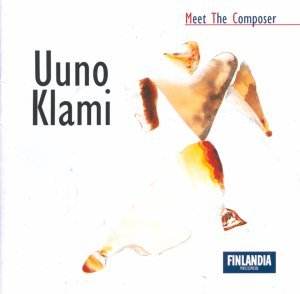Uuno Klami came from the generations that toiled under
the vast sun-sapping shadow of Sibelius. Composers struck out in new
directions to assert individuality and their own voice. While people
of the estimable stature of Ernest Pingoud and Väinö Raitio
tapped into the fresh breezes blowing in from Prokofiev, Klami reached
towards the impressionistic models of Ravel and Debussy and the Stravinsky
of The Firebird. Later he dabbled in jazzy patterns and Parisian
brilliance.
After the murky All'Ouverture, a sort of sepia-draped
Karelia, comes the delicate pastel-wash fantasy of the Sea
Pictures. Klami loved the sea. This work will almost certainly appeal
to anyone who already likes the Ravel of Ma Mère l'Oye,
the Nielsen of Pan and Syrinx and the Sibelius of The Oceanides.
The Deserted Three-Master has a fine swinging tune and Captain
Scrapuchinat has a quiet pummelling note-figure that sounds like
the distant heart-beat of a steamer. The suite of six movements ends
with the so-called 3 Bf (a reference to a windforce point on
the Beaufort scale) which is modestly notorious for its unblushing appropriation
of a distinctive melodic cell (and one or two other things) from Ravel's
Bolero.
The Kalevala Suite grew very gradually, only
emerging fully formed in 1943. It is the freshest of works from a composer
having the temerity to venture into territory considered the peculiar
property of the Master of Järvenpää. It is a Sibelian
piece in which pounding Karelian material meets the deliquescent style
of The Firebird and to a lesser degree of The Rite of Spring
and Petrushka. The tender Cradle Song of Lemminkäinen
is rather too sleepily outlined by Segerstam but the remainder of
the works go with a swing and gripping sway. Most impressive is the
effervescent Sibelian welling sunrise of The Forging of the Sampo
which resolves into a metallic eruptive blasting anvil cannonade.
The recordings appear to be digital with the only exception
being the Cheremissian Fantasy.
It really is way past time that Finlandia gave a new
lease of life to their recording of Psalmus for chorus and orchestra
(FACD369). This work in its monumental writing for chorus takes something
from Stravinsky in Oedipus Rex and Symphony of Psalms but
a lot more from Sibelius's Kullervo.
I have never regretted my expensive gamble on Klami
back in 1979. I was mooching around the London classical record shops
(Harold Moores, Direction Dean Street, HMV etc) with my long-suffering
wife and we found ourselves, not by chance, in Gramex, off Soho Square.
There in the Finnish music racks was a big gatefold Finlandia LP. Finlandia
was not a common label in those days. The recording was of the Panula
version of the Kalevala Suite and the Cheremissian Fantasy
(yes, the very same that launches CD2 of this set). The LP cover
was a strange painting of a naked pubescent girl rising like a goddess
from the water. The artist was Aksel Gallen-Kallela whose work adorns
so many Sibelius CD sleeves (one of the most instantly memorable being
the horseback Kullervo on the front of the EMI recording of the Kullervo
Symphony (1971, EMI SLS 807(2); Bournemouth SO/Berglund). I forked
out my £2.50. That was a lot of money for us in those days. After that
I chased down off-air recordings and copies of rare LPs via friends
in the US and elsewhere, Walter Wells, Marc Bernier and Mark Lehman.
The vitality of Arto Noras's playing in the Fantasy
already triumphantly affirmed by his advocacy for the Sallinen and Kokkonen
cello concertos, is much in evidence in the Cheremissian Fantasy.
It is based on Cheremis folk tunes. Although the oldest recording here
(approaching three decades) it has vibrant immediacy. The Violin Concerto
and the Second Piano Concerto stray between ravel and Shostakovich with
the Violin Concerto being the slightly more romantic of the two pieces.
This is the set by which Sibelians and
others sympathetic to Scandinavian music should be introduced to the
sympathetic melodic strengths and imagination of Uuno Klami.
Rob Barnett
